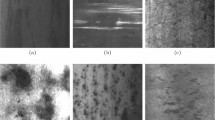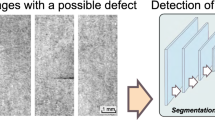Abstract
Penetration states significantly affect the service performance of weld products. For improving welding quality, it is essential to real-timely monitor the penetration states of molten pool during welding process. This study adopts arc sound signals to identify penetration states of weld seam. Firstly, the time–frequency spectrum images of arc sounds are obtained with short-time Fourier transform. And based on a convolution neural network, the penetration states of weld seam are identified. For improving the anti-interference ability of the proposed identification method, a mathematical model that simulates the functions of human auditory system is developed. The auditory spectrum images of arc sounds are acquired with this model. Based on the auditory spectrum images of arc sounds, the penetration states are identified. The experimental results show that the proposed method has high anti-interference ability. When the signal-to-noise ratio is less than 5 dB, the accuracy rate of identification keeps more than 95%.


















Similar content being viewed by others
Data availability
Not applicable.
Code availability
Not applicable.
References
Xiao RQ, Xu YL, Hou Zh, Chen H, Chen SB (2019) An adaptive feature extraction algorithm for multiple typical seam tracking based on vision sensor in robotic arc welding. Sens Actuators A:Physical 297:111533. https://doi.org/10.1016/j.sna.2019.111533
Yang D, Wang G, Zhang G (2017) A comparative study of GMAW- and DE-GMAW-based additive manufacturing techniques: thermal behavior of the deposition process for thin-walled parts. Int J Adv Manuf Technol 91:2175–2184. https://doi.org/10.1007/s00170-016-9898-0
Huang J, Yang M, Chen J et al (2018) The oscillation of stationary weld pool surface in the GTA welding. J Mater Process Technol 256:57–68
Song S, Chen H, Lin T et al (2016) Penetration state recognition based on the double-sound-sources characteristic of VPPAW and hidden Markov Model. J Mater Process Technol 234:33–44. https://doi.org/10.1016/j.jmatprotec.2016.03.002
Zhang Z, Chen S (2017) Real-time seam penetration identification in arc welding based on fusion of sound, voltage and spectrum signals. J Intell Manuf 28:207–218. https://doi.org/10.1007/s10845-014-0971-y
Lv N, Xu Y, Li S et al (2017) Automated control of welding penetration based on audio sensing technology. J Mater Process Technol 250:81–98. https://doi.org/10.1016/j.jmatprotec.2017.07.005
Zhang Z, Wen G, Chen S (2018) Audible sound-based intelligent evaluation for aluminum alloy in robotic pulsed GTAW: mechanism, feature selection, and defect detection. IEEE Trans Ind Informatics 14:2973–2983. https://doi.org/10.1109/TII.2017.2775218
Gao Y, Zhao J, Wang Q et al (2020) Weld bead penetration identification based on human-welder subjective assessment on welding arc sound. Meas J Int Meas Confed 154:107475. https://doi.org/10.1016/j.measurement.2020.107475
Gao Y, Wang Q, Xiao J, Zhang H (2020) Penetration state identification of lap joints in gas tungsten arc welding process based on two channel arc sounds. J Mater Process Tech 285:116762. https://doi.org/10.1016/j.jmatprotec.2020.116762
Haichao L, Liu J, Xie J, Wang X (2019) GTAW penetration prediction model based on convolution neural network algorithm. J Mech Eng 55:22–28
Ren W, Wen G, Liu S et al. (2018) Seam penetration recognition for GTAW using convolutional neural network based on time-frequency image of arc sound. IEEE 23rd Int Conf Emerg Technol Fact Autom ETFA 2018-Sept, pp 853–860. https://doi.org/10.1109/ETFA.2018.8502478
Wu D, Huang Y, Zhang P et al (2020) Visual-acoustic penetration recognition in variable polarity plasma arc welding process using hybrid deep learning approach. IEEE Access 8:120417–120428. https://doi.org/10.1109/ACCESS.2020.3005822
Shamma SA (1985) Speech processing in the auditory system II: lateral inhibition and the central processing of speech evoked activity in the auditory nerve. J Acoust Soc Am 78:1622–1632. https://doi.org/10.1121/1.392800
Patterson RD, Moore BCJ (1986) Auditory filters and excitation patterns as representations of auditory frequency selectivity. In: Moore BCJ (ed) Frequency Selectivity in Hearing. Academic Press, London, pp 123–177
Hewitt MJ, Meddis R (1991) An evaluation of eight computer models of mammalian inner hair-cell function. J Acoust Soc Am 90:904–917. https://doi.org/10.1121/1.401957
Wang K, Shamma SA (1995) Spectral shape analysis in the central auditory system. IEEE Trans Speech Audio Process 3:382–395. https://doi.org/10.1109/89.466657
Martin KD (1999) Sound-Source Recognition: a Theory and Computational Model. Dissertation, Massachusetts Institute of Technology
Patterson RD (2000) Auditory images : how complex sounds are represented in the auditory system. Acoust Sci Technol 21:183–190
ANSI S3.4-2007 (2007) Procedure for the computation of loudness of steady sounds. American National Standards Institute, Melville
Greenwood DD (1990) A cochlear frequency-position function for several species—29 years later. J Acoust Soc Am 87:2592–2605
Johannesma PIM (1988) Spectro-temporal interpretation of activity patterns of auditory neurons GERARD H. F M HESSELMANS 51:31–51
Funding
This work was supported by the Natural Science Foundation of Shanghai (21ZR1425900, 21010501600).
Author information
Authors and Affiliations
Contributions
Yanfeng Gao: conceptualization, methodology, writing—original draft preparation, funding acquisition.
Qisheng Wang: investigation.
Jianhua Xiao: data curation, visualization.
Genliang Xiong: writing—review and editing.
Hua Zhang: supervision, project administration.
Corresponding authors
Ethics declarations
Ethics approval
Not applicable
Consent to participate
All the authors listed have participated in the preparation of the manuscript.
Consent for publication
This manuscript is approved by all the authors for publication. It is the original research that has not been published previously, and not under consideration for publication elsewhere, in whole or in part.
Conflict of interest
The authors declare no competing interests.
Additional information
Publisher's note
Springer Nature remains neutral with regard to jurisdictional claims in published maps and institutional affiliations.
Recommended for publication by Commission XII - Arc Welding Processes and Production Systems
Rights and permissions
Springer Nature or its licensor holds exclusive rights to this article under a publishing agreement with the author(s) or other rightsholder(s); author self-archiving of the accepted manuscript version of this article is solely governed by the terms of such publishing agreement and applicable law.
About this article
Cite this article
Gao, Y., Wang, Q., Xiao, J. et al. Weld penetration identification with deep learning method based on auditory spectrum images of arc sounds. Weld World 66, 2509–2520 (2022). https://doi.org/10.1007/s40194-022-01373-7
Received:
Accepted:
Published:
Issue Date:
DOI: https://doi.org/10.1007/s40194-022-01373-7




